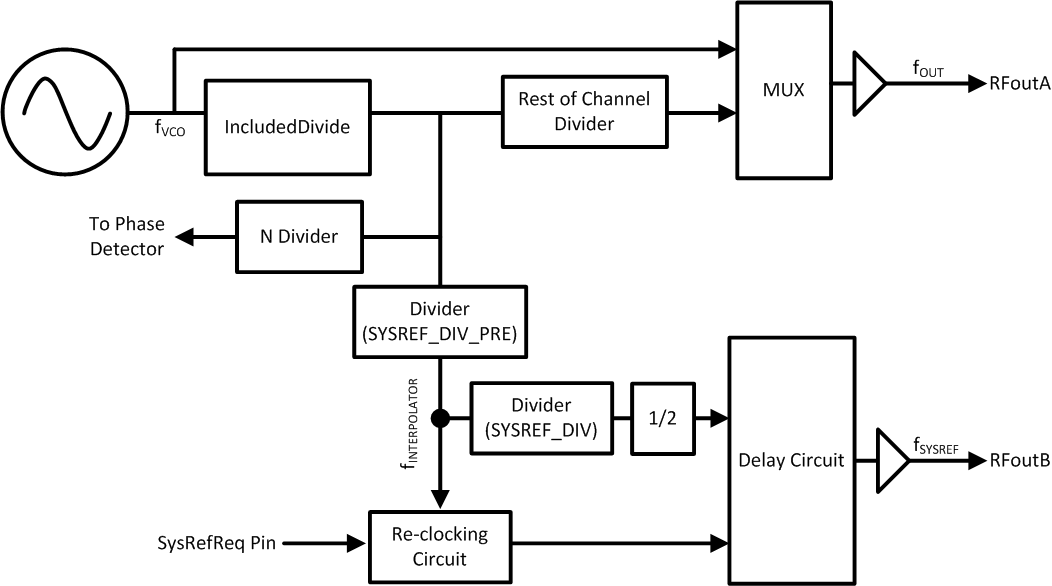ZHCSGL5C March 2017 – April 2019 LMX2594
PRODUCTION DATA.
- 1 特性
- 2 应用
- 3 说明
- 4 修订历史记录
- 5 Pin Configuration and Functions
- 6 Specifications
-
7 Detailed Description
- 7.1 Overview
- 7.2 Functional Block Diagram
- 7.3
Feature Description
- 7.3.1 Reference Oscillator Input
- 7.3.2 Reference Path
- 7.3.3 PLL Phase Detector and Charge Pump
- 7.3.4 N-Divider and Fractional Circuitry
- 7.3.5 MUXout Pin
- 7.3.6 VCO (Voltage-Controlled Oscillator)
- 7.3.7 Channel Divider
- 7.3.8 Output Buffer
- 7.3.9 Power-Down Modes
- 7.3.10 Phase Synchronization
- 7.3.11 Phase Adjust
- 7.3.12 Fine Adjustments for Phase Adjust and Phase SYNC
- 7.3.13 Ramping Function
- 7.3.14 SYSREF
- 7.3.15 SysRefReq Pin
- 7.4 Device Functional Modes
- 7.5 Programming
- 7.6
Register Maps
- 7.6.1 General Registers R0, R1, & R7
- 7.6.2 Input Path Registers
- 7.6.3 Charge Pump Registers (R13, R14)
- 7.6.4 VCO Calibration Registers
- 7.6.5 N Divider, MASH, and Output Registers
- 7.6.6 SYNC and SysRefReq Input Pin Register
- 7.6.7 Lock Detect Registers
- 7.6.8 MASH_RESET
- 7.6.9 SysREF Registers
- 7.6.10 CHANNEL Divider Registers
- 7.6.11 Ramping and Calibration Fields
- 7.6.12 Ramping Registers
- 7.6.13 Readback Registers
- 8 Application and Implementation
- 9 Power Supply Recommendations
- 10Layout
- 11器件和文档支持
- 12机械、封装和可订购信息
7.3.14 SYSREF
The LMX2594 can generate a SYSREF output signal that is synchronized to fOUT with a programmable delay. This output can be a single pulse, series of pulses, or a continuous stream of pulses. To use the SYSREF capability, the PLL must first be placed in SYNC mode with VCO_PHASE_SYNC = 1.
As Figure 30 shows, the SYSREF feature uses IncludedDivide and SYSREF_DIV_PRE divider to generate fINTERPOLATOR. This frequency is used for reclocking of the rising and falling edges at the SysRefReq pin. In master mode, the fINTERPOLATOR is further divided by 2 × SYSREF_DIV to generate finite series or continuous stream of pulses.
Table 18. SYSREF Setup
The delay can be programmed using the JESD_DAC1_CTRL, JESD_DAC2_CTRL, JESD_DAC3_CTRL, and JESD_DAC4_CTRL words. By concatenating these words into a larger word called "SYSREFPHASESHIFT", the relative delay can be found. The sum of these words should always be 63.
Table 19. SysRef Delay
| SYSREFPHASESHIFT | DELAY | JESD_DAC1 | JESD_DAC2 | JESD_DAC3 | JESD_DAC4 |
|---|---|---|---|---|---|
| 0 | Minimum | 36 | 27 | 0 | 0 |
| ... | 0 | 0 | |||
| 36 | 0 | 63 | 0 | 0 | |
| 37 | 62 | 1 | 0 | 0 | |
| ... | |||||
| 99 | 0 | 0 | 63 | 0 | |
| 100 | 0 | 0 | 62 | 1 | |
| ... | |||||
| 161 | 0 | 0 | 1 | 62 | |
| 162 | 0 | 0 | 0 | 63 | |
| 163 | 1 | 0 | 0 | 62 | |
| 225 | 63 | 0 | 0 | 0 | |
| 226 | 62 | 1 | 0 | 0 | |
| 247 | Maximum | 41 | 22 | 0 | 0 |
| > 247 | Invalid | Invalid | Invalid | Invalid | Invalid |
